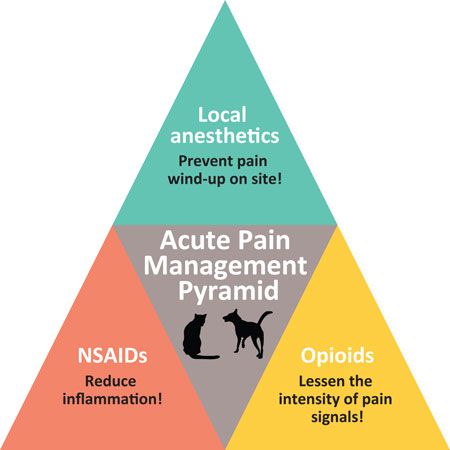The great acute pain management pyramid
One of the seven wonders of the veterinary world, the great acute pain management pyramid can give structure to your clinics pain strategy for dogs and cats.
Not long ago, it was common for patients (especially cats) to be anesthetized using only gas. At the time, veterinarians were unaware that anesthetic gas does not provide analgesia. “We tortured our patients,” says Robin Downing, DVM, MS, DAAPM, DACVSMR, CVPP, CCRP. But thankfully, as the old Virginia Slims cigarettes ads asserted back in the day, veterinary medicine has come a long way when it comes to acute pain management, baby. Equipped with better knowledge and the right combination of tools, we can avoid causing our feline and canine patients unnecessary pain and distress.
Pain particulars
Pain is complex, says Dr. Downing. Acute pain can stem from a planned event, like surgery, or an unplanned event, like trauma, and can vary in severity. Often, it isn't the only pain present. A patient could already be experiencing a chronic pain issue when acute pain begins.
We now know that pain becomes maladaptive as time goes on and can cause the patient to suffer, a process known as pain wind-up. To stop the wind-up before it begins, we can mount a preemptive strike against pain by being early, aggressive and in-tune with our patients and by having the right medicine at our disposal, says Dr. Downing. She's constructed a tri-level acute pain management pyramid to give some structure to what patients need.
Acute pain management pyramid
When it comes to managing acute pain, it is important to use every level of the pyramid in order to target specific tissues and receptors in the body. Prevention is the key!

Local anesthetic infusions
Examples: Lidocaine, bupivacaine
Since we now know that gas anesthesia affects consciousness only, we need to have a pain intervention strategy already in play when the patient wakes up. Local anesthetic infusions can help prevent wind-up at the surgical site. Local analgesics such as lidocaine and bupivacaine block pain signals at the site of the stimulus and thus alter pain perception. These medications are affordable and easy to use, but they are not as effective long term and should be coupled with postoperative systemic pain coverage.
Nonsteroidal anti-inflammatory drugs
Examples: Carprofen, meloxicam, firocoxib, robenacoxib (cats only)
NSAIDs play a primary role in analgesia and should be a part of analgesic protocols. They reduce inflammation and can have primary analgesic effects. They affect multiple locations in the nervous system. NSAIDs can address pain in multiple ways and are a cornerstone to any anesthetic protocol.
Opioids
Examples: Morphine, hydromorphone, fentanyl, buprenorphine
Opioids are also effective at interrupting pain wind-up and can help slow tissue damage because we now know that pain interferes with healing. They also play a role on the mu receptors in sites of inflammation, such as a knee that has undergone cruciate repair, and thus can play a role as an infusion. Opioids' ability to moderate pain perception by reducing the intensity of pain signals reaching the brain and acting at the site of the pain makes them the MOST important component of the pain management pyramid.
Again, every level of the acute pain management pyramid is important and necessary because each has a different target. All three levels synergistically build on each other, and together, they work better than any one agent on its own.
Remember the 3 Rs
Because pain can be adaptive or maladaptive, Dr. Downing says veterinarians need to also be mindful of the three Rs of pain management:
- Recheck: Look at your patient again (and again).
- Reassess: Take into account anything that may have changed since your last check.
- Revise: Alter the pain management cocktail to meet the patient's current needs, and titrate the medications down as the patient heals.
Now that we know more about pain, appropriate pain management isn't just good medicine-it's a minimum standard of care. It is not just our job, but our obligation, to create comprehensive pain strategies for every patient, every time and to stay up-to-date as their pain needs change.
Podcast CE: A Surgeon’s Perspective on Current Trends for the Management of Osteoarthritis, Part 1
May 17th 2024David L. Dycus, DVM, MS, CCRP, DACVS joins Adam Christman, DVM, MBA, to discuss a proactive approach to the diagnosis of osteoarthritis and the best tools for general practice.
Listen